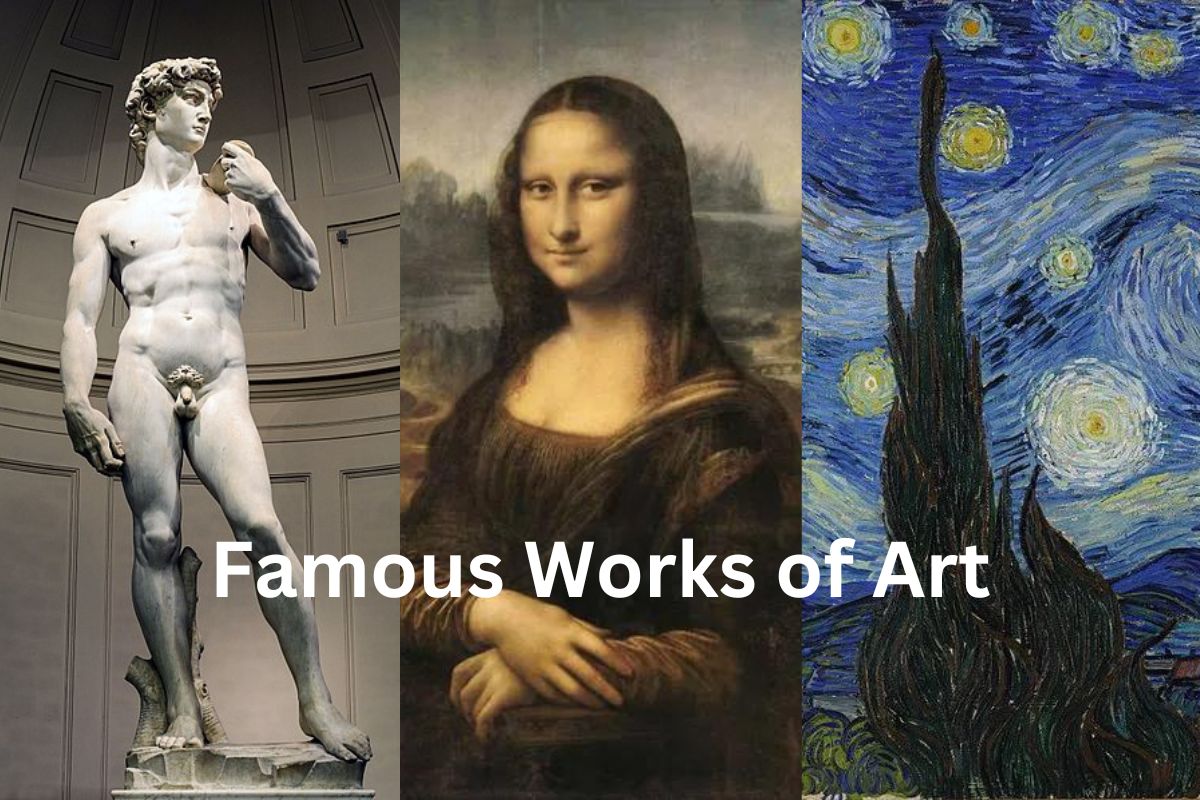Art has been an integral part of human history and culture for centuries, reflecting the times, ideas, and emotions of people from different regions and eras.
Throughout history, artists have created masterpieces that have captivated and inspired people for generations.
The list of the most famous works of art includes some of the most iconic and recognizable pieces ever created. These works span centuries and styles, from Renaissance paintings to great sculptures.
They are often celebrated for their beauty, technical mastery, emotional impact, and cultural significance.
While each of these works is unique, they all share the ability to move, challenge, and inspire viewers in different ways.
From the enigmatic smile of the Mona Lisa to the explosive energy of The Scream, these pieces continue to capture the imagination of art lovers around the world.
Famous Works of Art
1. The Mona Lisa – Leonardo da Vinci
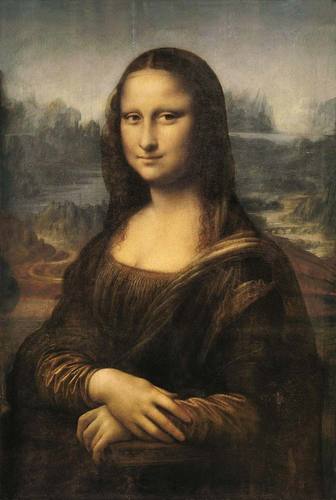
The Mona Lisa is a 16th-century portrait painted by the Italian artist Leonardo da Vinci. The painting, also known as La Gioconda, depicts a seated woman, believed to be Lisa Gherardini, the wife of a Florentine merchant.
The painting is famous for its enigmatic smile, which has fascinated art enthusiasts for centuries.
The Mona Lisa is painted with oil on a panel of poplar wood and is widely considered one of the greatest masterpieces of the Italian Renaissance.
The painting’s composition, with the sitter positioned in front of a landscape and a winding road, was innovative for its time and has been emulated by countless artists since.
The Mona Lisa is currently on display at the Louvre Museum in Paris, where it draws millions of visitors each year. It has been the subject of numerous theories, debates, and controversies, and its enduring popularity and cultural significance have made it one of the most famous works of art in the world.
2. The Starry Night – Vincent van Gogh
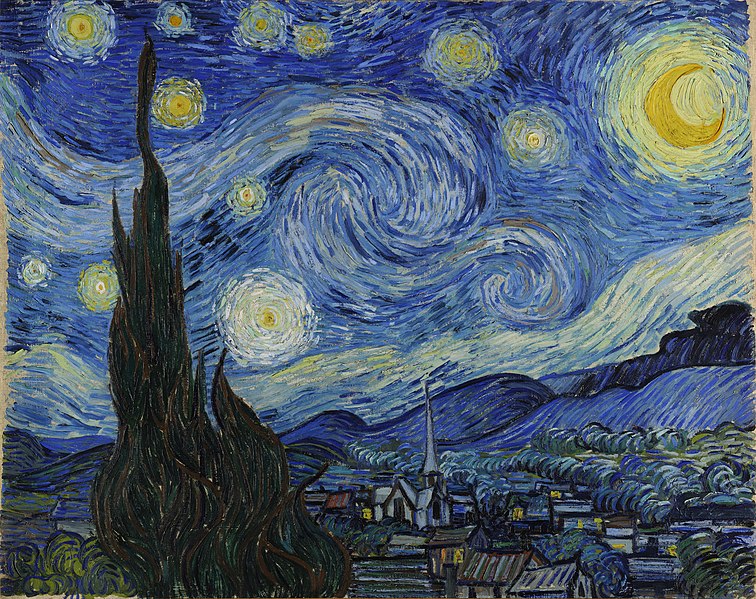
The Starry Night is an oil painting created by the Dutch post-impressionist artist Vincent van Gogh in 1889. The painting depicts the view from Van Gogh’s asylum room in Saint-Paul-de-Mausole, where he was undergoing treatment for mental illness.
The painting shows a stylized landscape with a small village, cypress trees, and a swirling sky filled with stars and vibrant colors. The work is known for its distinctive style, which combines elements of impressionism and expressionism to create a unique, dream-like vision of the world.
The Starry Night is considered one of Van Gogh’s greatest works and has become an icon of Western art.
It has been widely reproduced and imitated in popular culture and is recognized as a symbol of the power of artistic expression to convey intense emotions and psychological states. It is currently housed in the Museum of Modern Art in New York City.
3. Girl with a Pearl Earring – Johannes Vermeer
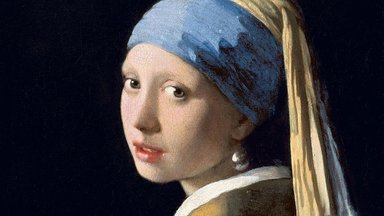
Girl with a Pearl Earring is a 17th-century painting created by the Dutch artist Johannes Vermeer. The painting depicts a young woman wearing a headscarf and a large pearl earring, looking over her shoulder at the viewer. The painting is famous for its use of light and shadow, and the enigmatic expression of the sitter.
The identity of the sitter is unknown, and the painting has been interpreted in different ways, from a simple portrait to a symbol of feminine beauty and mystery. The painting has been widely reproduced and is considered one of Vermeer’s most famous works.
Girl with a Pearl Earring is currently housed at the Mauritshuis museum in The Hague, Netherlands, and is regarded as a masterpiece of Dutch Golden Age painting.
The painting has been the subject of numerous adaptations, including a popular novel and a film, and its enduring popularity has made it one of the most recognizable and celebrated works of art in the world.
4. David – Michelangelo
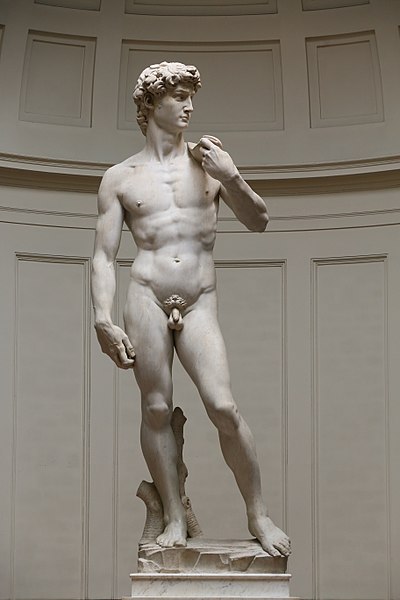
David is a sculpture created by the Italian artist Michelangelo between 1501 and 1504. The statue depicts the biblical hero David, who defeated the giant Goliath with a stone from his slingshot. The sculpture stands at 5.17 meters (17 feet) tall and is made of marble.
David is widely considered one of Michelangelo’s greatest masterpieces and a masterpiece of Renaissance sculpture. The statue is renowned for its anatomical accuracy, exquisite detail, and the sense of movement and tension it conveys.
The statue was originally installed in the Piazza della Signoria in Florence, Italy, but was later moved to the Accademia Gallery in Florence to protect it from weather and pollution.
The statue has become a symbol of Florentine pride and Italian Renaissance art, and it is one of the most famous sculptures in the world. Its influence can be seen in countless works of art, literature, and popular culture, and it continues to inspire and captivate viewers today.
5. The Kiss – Gustav Klimt
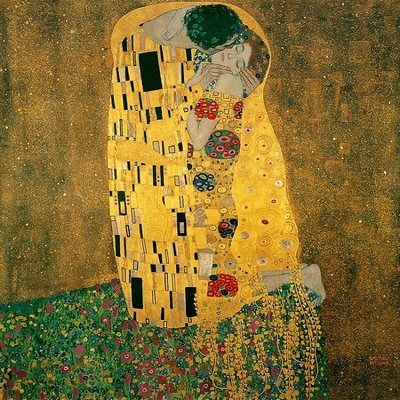
The Kiss is an oil painting created by the Austrian artist Gustav Klimt in 1907-1908. The painting depicts a couple embracing and kissing, enveloped by a golden veil of flowers and geometric shapes. The painting is famous for its ornate, decorative style, which reflects Klimt’s interest in the Art Nouveau movement.
The Kiss is widely regarded as one of Klimt’s most famous works and a masterpiece of the Vienna Secession art movement. The painting is known for its sensuality, intimacy, and the intricate patterns and symbols that adorn the couple’s clothing and the surrounding environment.
The painting is currently housed at the Österreichische Galerie Belvedere museum in Vienna, Austria.
The Kiss has been widely reproduced and has become a symbol of love and romance in popular culture. Its influence can be seen in fashion, advertising, and art, and it continues to inspire and enchant viewers today.
6. The Birth of Venus – Sandro Botticelli
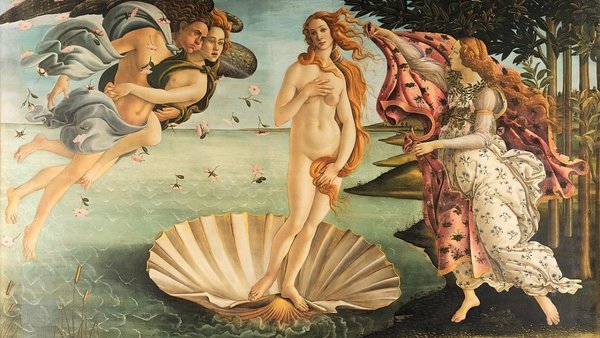
The Birth of Venus is a painting created by the Italian artist Sandro Botticelli in the mid-1480s. The painting depicts the goddess Venus, born fully grown from the sea, standing on a seashell and surrounded by other mythical figures.
The painting is famous for its beautiful depiction of the female form, the flowing lines of the figures, and the vibrant colors and ornate details of the clothing and accessories. The painting is considered a masterpiece of the Italian Renaissance and has become an icon of Western art.
The Birth of Venus is currently housed at the Uffizi Gallery in Florence, Italy, where it draws millions of visitors each year. The painting has been widely reproduced and imitated in popular culture, and it continues to inspire and captivate viewers today.
7. Sistine Chapel ceiling – Michelangelo
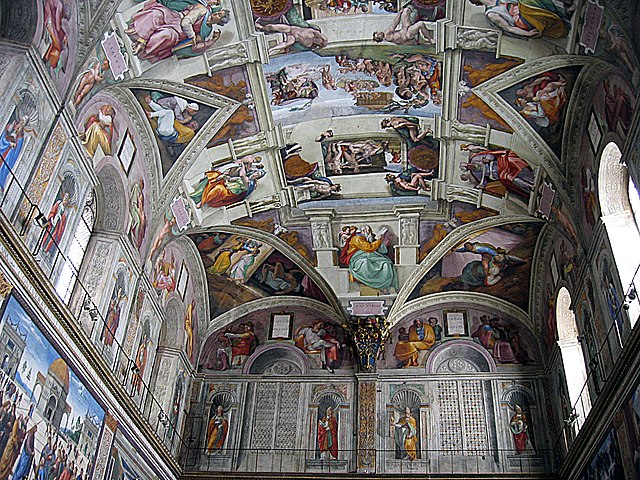
The Sistine Chapel ceiling is a masterpiece of Renaissance art created by the Italian artist Michelangelo between 1508 and 1512.
The ceiling of the chapel, located in Vatican City, Rome, is decorated with a series of nine panels depicting scenes from the Old Testament, including the creation of Adam, the temptation and expulsion from the Garden of Eden, and the Great Flood.
The Sistine Chapel ceiling is famous for its extraordinary beauty, the technical mastery of its execution, and its cultural and religious significance. The frescoes are painted in bright colors and intricate details, and Michelangelo’s innovative use of perspective and anatomy has made them some of the most celebrated and influential works of art in the world.
The Sistine Chapel ceiling continues to attract millions of visitors each year and is recognized as one of the greatest achievements in the history of art. The frescoes have been widely reproduced and imitated in popular culture, and their enduring popularity has made them one of the most famous works of art in the world.
8. The Last Supper – Leonardo da Vinci

The Last Supper is a 15th-century mural painting created by the Italian artist Leonardo da Vinci. The painting depicts the scene of the Last Supper, where Jesus Christ shares his final meal with his apostles before his crucifixion.
The painting is famous for its composition, which captures the emotional reactions of the apostles to the news of Jesus’ impending betrayal. The painting is also renowned for its use of perspective and lighting, which creates a sense of depth and realism.
The Last Supper is painted on the wall of the dining hall of the Santa Maria delle Grazie church in Milan, Italy. The painting has suffered damage over the years, but it remains a celebrated masterpiece of Renaissance art and a testament to Leonardo da Vinci’s genius.
9. Las Meninas – Diego Velázquez
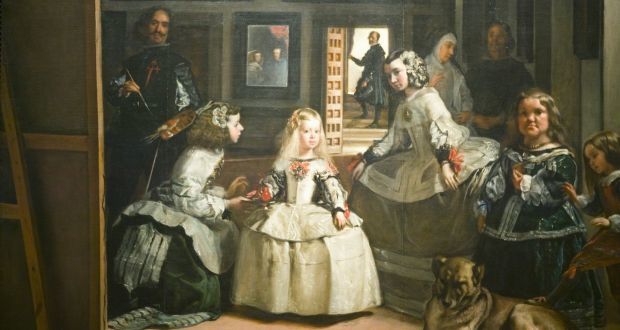
Las Meninas is a 17th-century painting created by the Spanish artist Diego Velázquez. The painting depicts a group of people in the royal court of King Philip IV of Spain, including the young Infanta Margaret Theresa, her ladies-in-waiting, and the artist himself.
The work is famous for its complexity and ambiguity, with the viewer positioned as if they were standing in the same room as the figures, but also as if they were being watched by them.
It is known for its masterful use of light and shadow, and its intricate details, which reveal the hierarchy and power dynamics of the court.
Las Meninas is currently housed at the Prado Museum in Madrid, Spain, and is regarded as one of the greatest masterpieces of Spanish art. The painting has been widely studied and analyzed by art historians and has influenced countless artists in the centuries since its creation.
10. Venus de Milo – Alexandros of Antioch
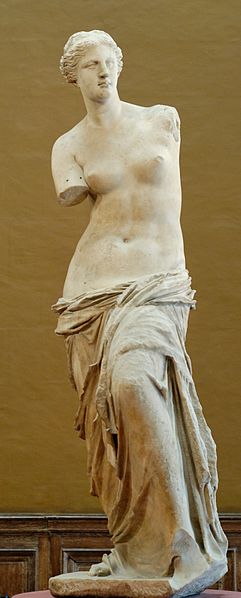
Venus de Milo is an ancient Greek sculpture created by an unknown artist, and believed to have been discovered on the island of Milos, Greece, in 1820. The statue depicts the goddess Aphrodite (Venus in Roman mythology) in a standing pose, with her arms missing.
The statue is famous for its graceful, elegant form and its idealized depiction of female beauty. The sculpture is thought to have been created during the Hellenistic period, around the 2nd century BCE, and is attributed to the sculptor Alexandros of Antioch.
Venus de Milo is currently housed at the Louvre Museum in Paris, France, where it is one of the most popular and beloved works of art in the museum’s collection. The statue has become an icon of classical Greek art, and its influence can be seen in countless works of art and popular culture.
11. Guernica – Pablo Picasso
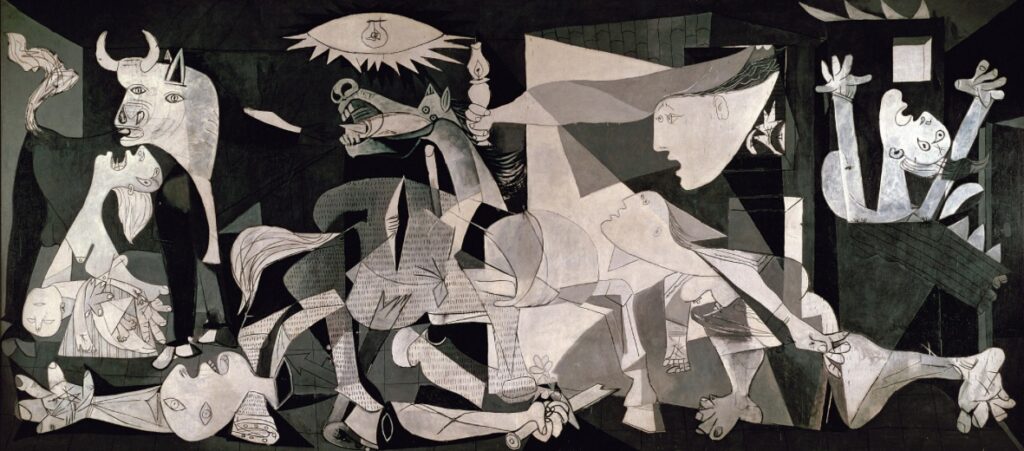
Guernica is a large-scale mural painting created by the Spanish artist Pablo Picasso in 1937. The painting depicts the horrors of war and the suffering of innocent civilians, specifically inspired by the bombing of the Spanish town of Guernica during the Spanish Civil War.
The work of art is famous for its abstract, Cubist style, and its powerful political and social commentary. The use of stark black, white, and grey colors adds to the sense of chaos and destruction, while the images of horses, bulls, and wounded people convey a sense of violence and suffering.
Guernica is currently housed at the Museo Reina Sofía in Madrid, Spain, and is recognized as one of the most important works of 20th-century art.
12. The Creation of Adam – Michelangelo

The Creation of Adam is a fresco painting created by the Italian artist Michelangelo on the ceiling of the Sistine Chapel in Vatican City, Rome. The painting depicts the Biblical story of the creation of man, with God reaching out to touch the outstretched hand of Adam.
The painting is famous for its powerful symbolism, technical mastery, and its use of light and shadow to create a sense of depth and movement. The image of God’s hand and Adam’s hand nearly touching has become an iconic representation of the human desire to reach out to the divine.
The Creation of Adam is considered one of Michelangelo’s greatest masterpieces and a masterpiece of Renaissance art.
13. The Thinker – Auguste Rodin
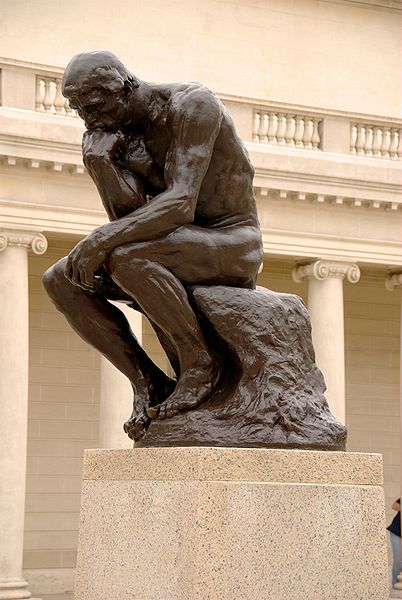
The Thinker is a bronze sculpture created by the French artist Auguste Rodin in 1902. The sculpture depicts a man in a seated position, deep in thought, with his chin resting on his hand.
The Thinker is famous for its realistic portrayal of the human form and its powerful symbolism. The sculpture is often seen as a representation of human intellect and the power of the human mind.
The sculpture has been widely reproduced and imitated in popular culture, and its image has become synonymous with philosophical reflection and contemplation.
The Thinker is currently housed at the Musée Rodin in Paris, France, and is recognized as one of the greatest masterpieces of modern sculpture.
14. Impression, Sunrise – Claude Monet
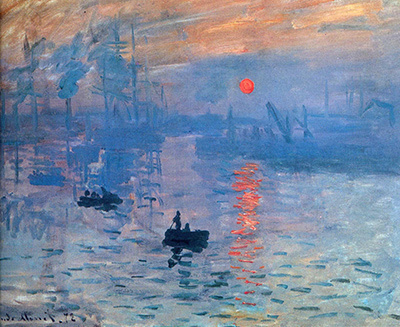
Impression, Sunrise is an oil painting created by the French artist Claude Monet in 1872. The painting depicts the port of Le Havre at sunrise, with a series of small boats and ships in the foreground, and the sun rising in the distance.
The painting is famous for its vibrant colors and loose brushwork, which created a sense of movement and atmosphere. The painting was part of an exhibition in Paris in 1874 that marked the beginning of the Impressionist movement, and it is considered one of the movement’s most important works.
Impression, Sunrise is currently housed at the Musée Marmottan Monet in Paris, France, and is recognized as a masterpiece of Impressionist art. The painting has been widely reproduced and imitated in popular culture, and its influence can be seen in countless works of art and design.
15. A Sunday Afternoon on the Island of La Grande Jatte – Georges Seurat
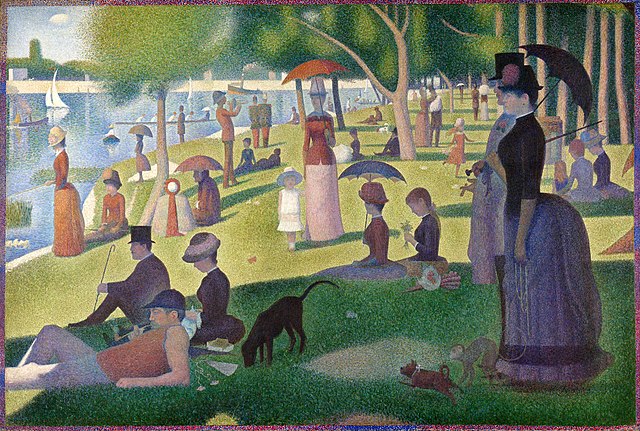
A Sunday Afternoon on the Island of La Grande Jatte is a painting created by the French artist Georges Seurat in 1884-1886. The painting depicts a group of people enjoying a leisurely afternoon on the banks of the Seine River, on the island of La Grande Jatte, near Paris.
The painting is famous for its pointillist technique, which uses small dots of color to create a sense of luminosity and atmosphere. The painting is also renowned for its monumental scale and its meticulous attention to detail, with each figure and object in the scene rendered with precision and clarity.
A Sunday Afternoon on the Island of La Grande Jatte is currently housed at the Art Institute of Chicago in Chicago, Illinois, and is recognized as one of the greatest masterpieces of Impressionist art.
16. David – Donatello
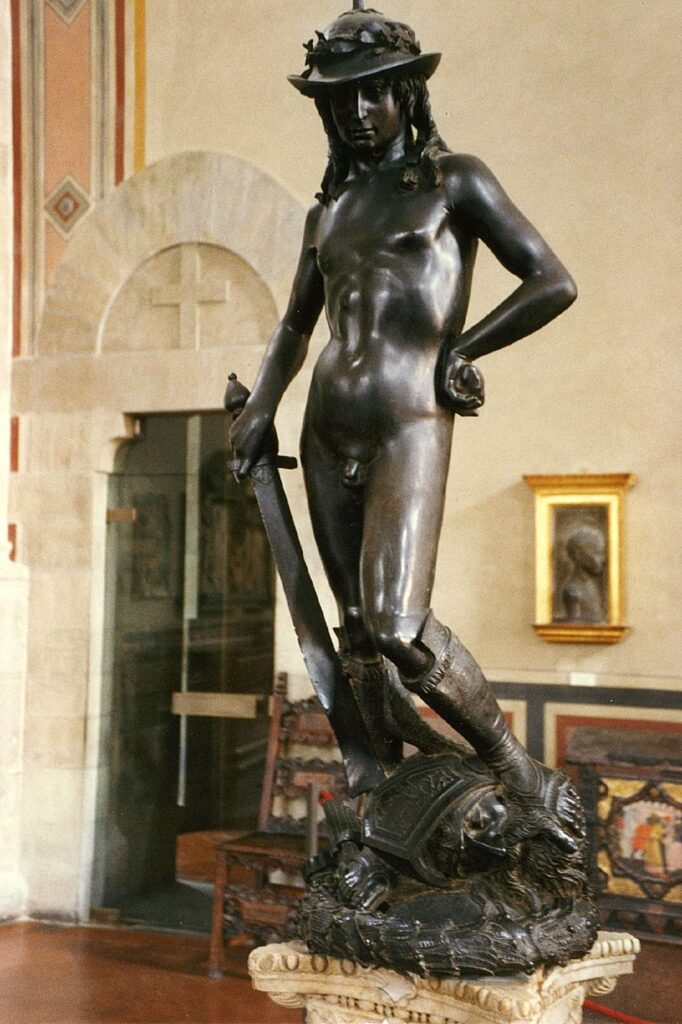
David is a sculpture created by the Italian Renaissance artist Donatello in the early 15th century. The statue depicts the biblical hero David, who defeated the giant Goliath with a stone from his slingshot.
Donatello’s David is famous for its revolutionary approach to sculpture, which emphasizes naturalism, individuality, and movement.
The statue shows David in a relaxed, contrapposto pose, with a slight twist of the torso and a contemplative expression on his face. The use of bronze as the material for the statue, and the intricate details of the hair and clothing, are also notable features.
The sculpture was originally installed in the courtyard of the Palazzo Medici in Florence, Italy, but it is currently housed at the Bargello museum in Florence.
17. The Night Watch– Rembrandt van Rijn

The Night Watch is a painting created by the Dutch artist Rembrandt van Rijn in 1642. The painting depicts a group of militia men from the city of Amsterdam, who are preparing to march out on a mission, and was originally titled “The Company of Frans Banning Cocq and Willem van Ruytenburch.”
The Night Watch is famous for its dramatic use of light and shadow, and the dynamic composition, which creates a sense of movement and action. The painting also captures the individuality and personality of each of the figures, making them seem like real people rather than just archetypes.
The Night Watch is currently housed at the Rijksmuseum in Amsterdam, Netherlands, and is regarded as one of the greatest masterpieces of Dutch Golden Age painting.
18. The Pietà – Michelangelo
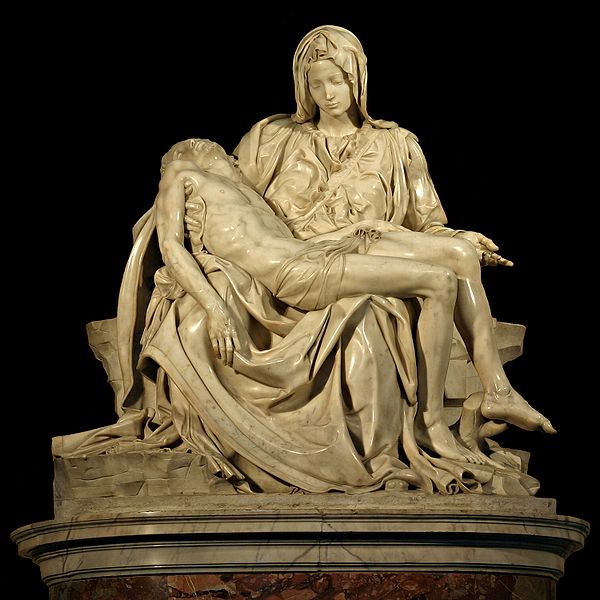
The Pietà is a sculpture created by the Italian artist Michelangelo between 1498 and 1499. The sculpture depicts the body of Jesus Christ after his crucifixion, being held by the Virgin Mary.
The sculpture is famous for its technical mastery, emotional power, and its expression of deep sorrow and grief. The delicate features of the Virgin Mary and the powerful musculature of Christ’s body are a testament to Michelangelo’s skill as a sculptor.
The Pietà is currently housed at St. Peter’s Basilica in Vatican City, Rome, and is regarded as one of the greatest masterpieces of Renaissance sculpture.
19. Whistler’s Mother – James Abbott McNeill Whistler
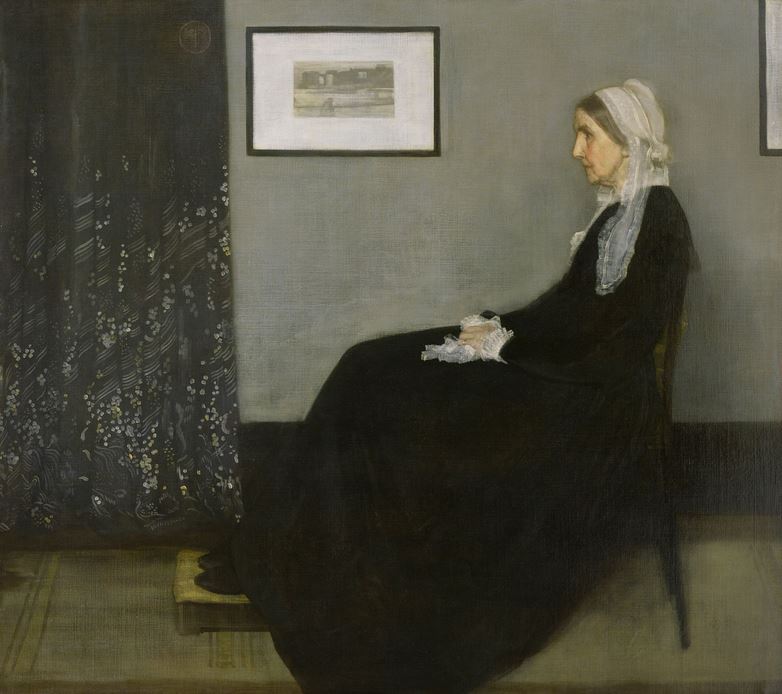
Whistler’s Mother is a painting created by the American artist James Abbott McNeill Whistler in 1871. The painting depicts Whistler’s mother, Anna McNeill Whistler, seated in a chair, with her hands clasped in her lap.
It is noted for its simple, yet powerful composition, and the expression of quiet dignity and strength conveyed by the figure of Whistler’s mother.
The painting is also renowned for its use of color, with the neutral tones of the clothing and background contrasting with the black dress worn by Whistler’s mother.
Whistler’s Mother is currently housed at the Musée d’Orsay in Paris, France, and is recognized as one of the greatest masterpieces of American art.
20. Liberty Leading the People – Eugène Delacroix
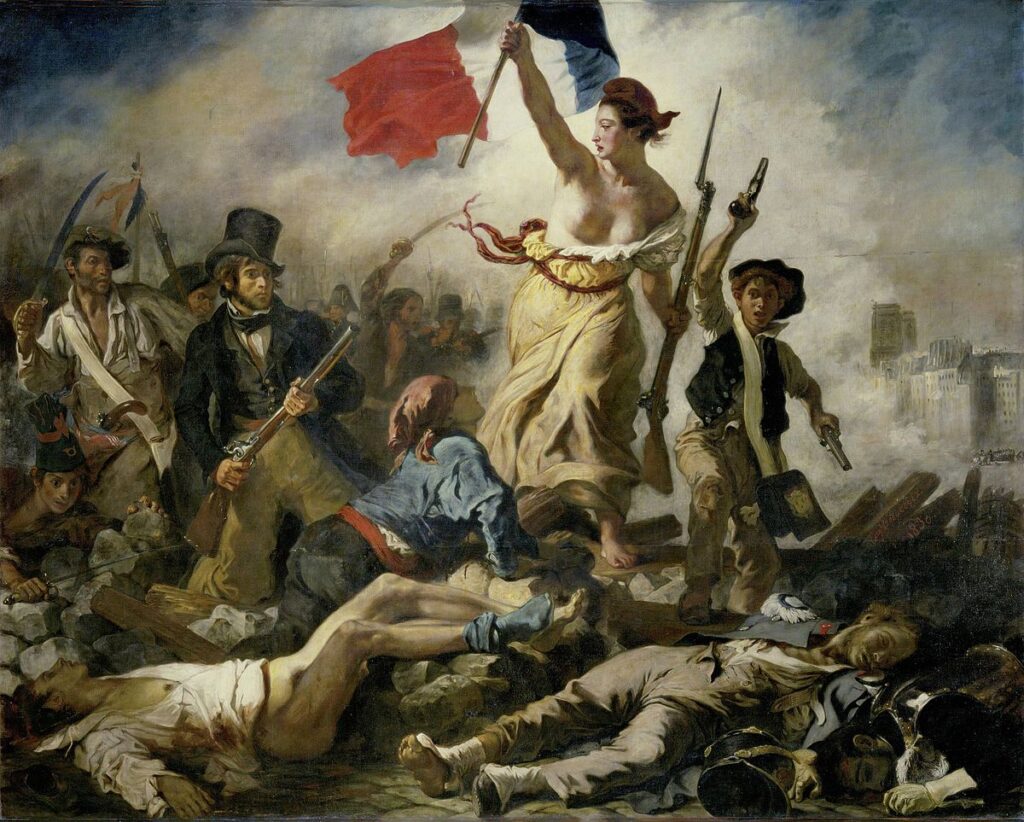
Liberty Leading the People is a painting created by the French artist Eugène Delacroix in 1830. The painting depicts a woman personifying the concept of Liberty leading a group of people over the barricades during the July Revolution in Paris, which resulted in the overthrow of King Charles X.
The painting is famous for its dramatic composition, use of vivid colors, and its powerful political and social commentary. The image of Liberty leading the people has become an iconic symbol of the French Revolution and of the struggle for freedom and democracy.
Liberty Leading the People is currently housed at the Louvre Museum in Paris, France, and is recognized as one of the greatest masterpieces of French Romanticism.
21. The Garden of Earthly Delights – Hieronymus Bosch
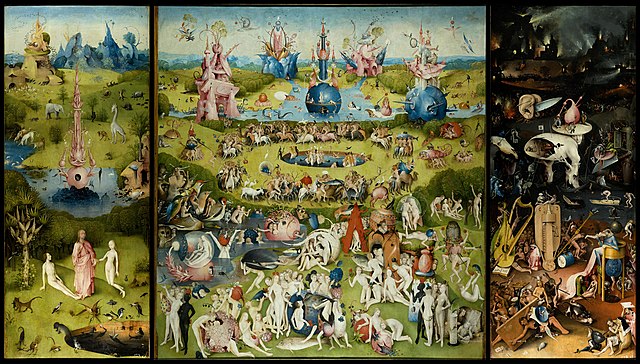
The Garden of Earthly Delights is a triptych painting created by the Dutch artist Hieronymus Bosch in the early 16th century. The painting depicts a surreal, fantastical landscape with strange creatures and allegorical figures.
The left panel of the triptych shows the Garden of Eden, with Adam and Eve and the Tree of Knowledge. The central panel shows a world filled with various creatures, human figures engaged in sensual pleasures, and disturbing scenes of violence and torture.
The right panel shows the consequences of the central panel’s actions, with a bleak and desolate landscape.
The Garden of Earthly Delights is famous for its bizarre, dreamlike imagery and its deep symbolism. The painting has been interpreted in many ways, with some seeing it as a warning against the dangers of excess and indulgence, while others see it as a celebration of life’s pleasures.
The painting is currently housed at the Museo del Prado in Madrid, Spain, and is recognized as one of the greatest masterpieces of Renaissance art
22. Arnolfini Portrait – Jan van Eyck
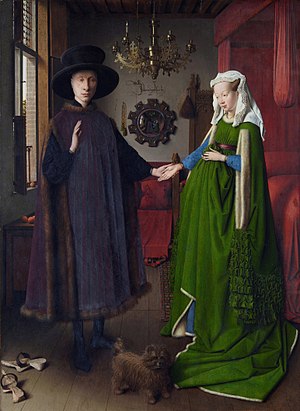
The Arnolfini Portrait is a painting created by the Flemish artist Jan van Eyck in 1434. The painting depicts a man and a woman, believed to be Giovanni di Nicolao Arnolfini and his wife, standing in a room filled with elaborate furnishings and decorations.
The painting is famous for its meticulous attention to detail, with every object in the room rendered with precision and accuracy. The use of light and shadow and the vibrant colors give the painting a sense of depth and richness.
The Arnolfini Portrait is currently housed at the National Gallery in London, UK, and is recognized as one of the greatest masterpieces of Northern Renaissance art.
23. The Persistence of Memory – Salvador Dalí
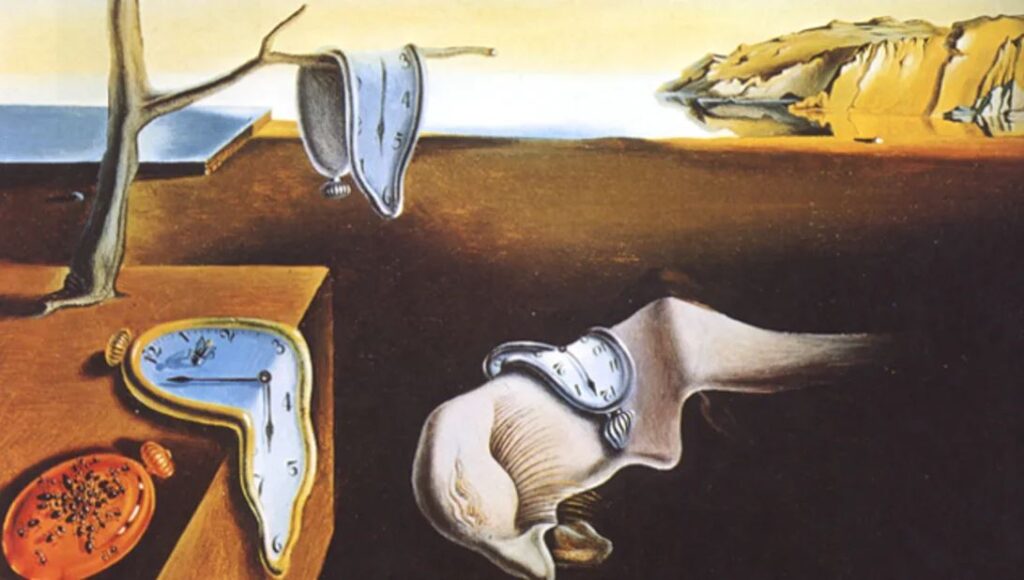
The Persistence of Memory is a painting created by the Spanish artist Salvador Dalí in 1931. The painting depicts a surreal, dreamlike landscape with a series of melting watches draped over various objects.
The painting is famous for its depiction of time and memory, with the melting watches representing the fluidity of time and the way that memories can distort and reshape our perceptions of the world. The painting is also noted for its use of a barren, desert landscape and its eerie, almost haunting atmosphere.
The Persistence of Memory is currently housed at the Museum of Modern Art in New York City, USA, and is recognized as one of the greatest masterpieces of Surrealist art.

